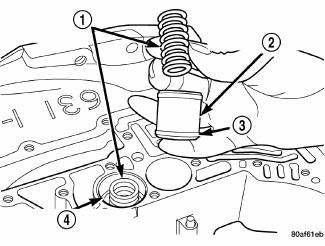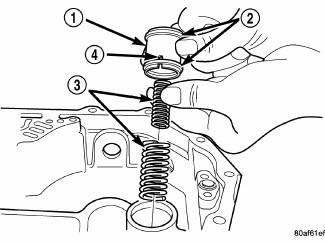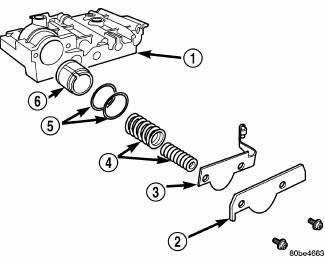Dodge Journey: Accumulator
DESCRIPTION

Fig. 238: Identifying Underdrive & Overdrive Accumulators
- - RETURN SPRING
- - UNDERDRIVE CLUTCH ACCUMULATOR
- - SEAL RING (2)
- - OVERDRIVE CLUTCH ACCUMULATOR
The 41TE underdrive, overdrive, low/reverse, and 2/4 clutch hydraulic circuits each contain an accumulator. An accumulator typically consists of a piston (2), seal rings (3) return spring(s) (1) and a cover or plug. The overdrive and underdrive accumulators are located within the transaxle case, and are retained by the valve body.

Fig. 239: Removing/Installing Low/Reverse Accumulator Return Springs
- - ACCUMULATOR PISTON
- - SEAL RINGS
- - RETURN SPRINGS
- - (NOTE NOTCH)
The low reverse accumulator (1) is also located within the transaxle case, but the assembly is retained by a cover and a snap-ring.

Fig. 240: Identifying 2/4 Accumulator Assembly
- - VALVE BODY
- - RETAINER PLATE
- - DETENT SPRING
- - VALVE BODY
- - RETAINER PLATE
- - DETENT SPRING
The 2/4 accumulator is located in the valve body (1) . It is retained by a cover and retaining screws.
OPERATION
The function of an accumulator is to cushion the application of a frictional clutch element. When pressurized fluid is applied to a clutch circuit, the application force is dampened by fluid collecting in the respective accumulator chamber against the piston and spring(s). The intended result is a smooth, firm clutch application
 Schematics and diagrams
Schematics and diagrams
40/41TE - WITH VARIABLE LINE PRESSURE
Fig. 181: Identifying Line Pressure - Park & Neutral
Fig. 182: Identifying Line Pressure - Reverse
Fig. 183: Identifying Line Pressure - First Gear ( ...
See also:
Removal
WARNING: Review safety precautions and warnings in this part
before performing
this procedure. Failure to
follow the warnings and cautions could result in possible serious or
fata ...
Diagnosis and Testing, Removal, Installation
DIAGNOSIS AND TESTING
INSTRUMENT CLUSTER
As a quick diagnosis, the cluster will perform a functional check of the
odometer display, transmission range
display and warning indicators after the ign ...
ENGINE COMPARTMENT — 3.5L
ENGINE COMPARTMENT — 3.5L
1 — Engine Coolant Reservoir.
6 — Totally Integrated Power Module (TIPM).
2 — Power Steering Fluid Reservoir.
7 — Air Cleaner Filter.
3 — Brake Fluid Reser ...

